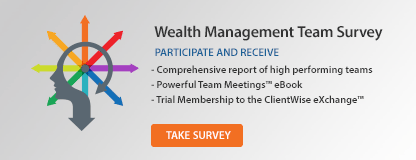6 Techniques To Maximize Your Relationships with Key Influencers
 One of the most rewarding aspects of coaching financial advisors is realizing how the measures we use to create progress in the coaching relationship can also be used by the financial advisors to create success in their other professional relationships. This makes our jobs twice as effective because we’re not only using coaching to further our coaches in their progress toward their goals, we are providing them with the option to mirror these techniques on their own.
One of the most rewarding aspects of coaching financial advisors is realizing how the measures we use to create progress in the coaching relationship can also be used by the financial advisors to create success in their other professional relationships. This makes our jobs twice as effective because we’re not only using coaching to further our coaches in their progress toward their goals, we are providing them with the option to mirror these techniques on their own.
This occurs most directly when financial advisors mirror these tactics with team members, but it applies to their financial advisor centers of influence as well, including professional advocates and loyal client advocates. Take, for example, some of the skills we use in the Advanced Coaching Skills section of our Certified Financial Services Coach Training Program:
Acknowledge costs and limitations: In coaching, this is about understanding where you personally view your limitations to be in terms of your goals and achievements. These negative beliefs limit people’s ability to think bigger, create more powerfully, and achieve at a higher level. These beliefs constrain, rather than empower the coachee. Like an individual, every relationship also has its perceived limitations and costs, which are usually based on a lack of communication between the partners in the relationship. Consistent communication between the financial advisor and his or her centers of influence allows the space to observe the limitations of the partnership.
Find the new opportunities: Once the costs and limitations are exposed, the partner’s can then explore whether these limitations are perceived or actual, providing them a path and opportunity to find ways to overcome them. In coaching, finding new opportunities rapidly engages the coachee in growth. It involves the coach encouraging the coachee to list every single opportunity without limitation. This same tactic can work well in referral partnerships, in which the partners in the relationship encourage each other to push their boundaries by exploring other opportunities they might not have previously considered while working together.
Create enhanced measures: Sometimes creating new opportunities occurs by changing the way you measure these opportunities. In coaching, coachees grow towards change when they begin to measure themselves and their capabilities at a higher level. The same can be true for the center of influence relationships, in which you set new expectations of success for your referrals, and the outcomes you wish to achieve through these referrals.
Ask for more: This is simple. In goal setting with your centers of influence, use these enhanced measures to set the standard beyond what you normally would by asking for more. Do your best to make the increased ask beneficial to both parties. This is easier in situations in which you are working in a professional advocate relationship, rather than a loyal client advocate relationship, but it can work in both scenarios, as long as you get the two people in the partnership to think bigger about what they are capable of and want out of the relationship. This skill is also beneficial because it communicates to the other person in the party that you have a belief in him or her as an individual, in addition to belief in the partnership.
Find the new reality: As you learn and grow in your relationship with your centers of influence, whether with clients or professionals, you will naturally come to easier ways of making decisions, solving problems, and moving forward in your partnerships. Allow room for this to happen, and adjust as quickly as possible to this new reality. Challenge each other to get to this place of finding the new reality as quickly as possible. This will allow the greatest room for growth, rather than letting you fall back into a pattern of old habits that don’t access your greatest potential.
Make progress every day: In coaching there should always be forward movement by the coachee. It should, at times, be new thinking, but ultimately thinking must turn into action. The same is true of your advocate relationships. The amount of interacting you do with each other should be balanced by forward movement from each party in the form of making introductions. This should happen according to a plan and it should work to keep you both accountable for your respective center of influence goals.
Coaching questions from this article:
- How are you proactively working with your centers of influence to help the relationships take shape and grow?
- Do you have a process and tactics, like those above, that will help you make consistent and clear progress in the relationship?
- Do you have a common language with which to communicate this progress?
Topics: Leadership


